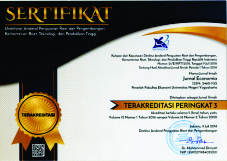The Mobile Payment Fintech Continuance Usage Intention in Indonesia
Downloads
Abstract: This research aimed to determine both positive and negative factors influencing the continuance usage intention of mobile payment FinTech in Indonesia. This research used an exploratory sequential mixed methods research design with a questionnaire as the first research instrument followed by semi-structured interviews. This research found that both the perceived benefit and perceived risk significantly influenced the mobile payment FinTech continuance usage intention in Indonesia but, the perceived benefit had a stronger impact than the perceived risk. Convenience had the most substantial positive impact on the perceived benefit, which later increased the mobile payment FinTech continuance usage intention. Financial risk had the strongest influence on the perceived risk, which later reduces the mobile payment FinTech continuance usage intention.
Keywords: mobile payment FinTech, continuance usage intention, Indonesian consumer
Niat Penggunaan Berkelanjutan dari Pembayaran Seluler Fintech di Indonesia
Abstrak: Tujuan dari penelitian ini adalah untuk menentukan faktor-faktor positif dan negatif yang mempengaruhi niat penggunaan berkelanjutan dari pembayaran seluler FinTech di Indonesia. Penelitian ini menggunakan desain penelitian metode campuran sekuensial eksploratori dengan kuesioner sebagai instrumen penelitian pertama diikuti oleh wawancara semi-terstruktur. Penelitian ini menemukan bahwa baik manfaat yang dirasakan maupun risiko yang dirasakan secara signifikan mempengaruhi kelanjutan penggunaan pembayaran seluler FinTech di Indonesia tetapi manfaat yang dirasakan memiliki dampak yang lebih kuat daripada risiko yang dirasakan. Kenyamanan memiliki dampak positif yang paling kuat pada manfaat yang dirasakan, yang kemudian meningkatkan niat kelanjutan penggunaan pembayaran seluler FinTech. Risiko keuangan memiliki pengaruh paling kuat pada risiko yang dirasakan, yang kemudian mengurangi niat kelanjutan penggunaan pembayaran seluler FinTech.
Kata kunci: mobile payment FinTech, niat kelanjutan penggunaan, konsumen Indonesia
Downloads
Abramova, S. & Bí¶hme, R. (2016). Perceived benefit and risk as multidimensional determinants of Bitcoin use: A quantitative exploratory study. Proceedings in International Conference on Information Systems, Dublin, 1-20.
Barakat, A. & Hussainey, K. (2013). Bank governance, regulation, supervision, and risk reporting: Evidence from operational risk disclosures in European banks. International Review of Financial Analysis, 30, 254-273.
Benlian, A. & Hess, T. (2011). Opportunities and risks of software-as-a-service: Findings from a survey of IT executives. Decision Support Systems, 52(1), 232-246.
Boonsiritomachai, W., & Pitchayadejanant, K. (2017). Determinants affecting mobile banking adoption by generation Y based on the Unified Theory of Acceptance and use of the technology model modified by the Technology Acceptance Model concept. Kasetsart Journal of Social Sciences. Available at: https://doi.org/10.1016/j.kjss.2017.10.005
Bryman, A. (2012). Social Research Methods. 4th ed. Oxford: Oxford University Press
Cheng, T.E., Lam, D.Y. & Yeung, A.C. (2006). Adoption of internet banking: An empirical study in Hong Kong. Decision Support Systems, 42(3), 1558-1572.
Chishti, S. (2016). How peer to peer lending and crowdfunding drive the FinTech revolution in the UK, in Tasca, P., Aste, T., Pelizzon, L. and Perony, N. (Eds). Banking Beyond Banks and Money, pp. 55-68. Berlin: Springer
Chuang, Li-Min, Liu, Chun-Chu & Kao, Hsiao-Kuang (2015). The adoption of FinTech service: TAM perspective. International Journal of Management and Administrative Sciences, 3(7), 1-15.
Cocosila, M., & Trabelsi, H. (2016). An integrated value-risk investigation of contactless mobile payments adoption. Electronic Commerce Research and Applications, 20, 159–170. https://doi.org/10.1016/j.elerap.2016.10.006
Cunningham, S.M. (1967). The major dimensions of perceived risk. Risk Taking and Information Handling in Consumer Behavior, 1, 82-111.
Davis, F.D., Bagozzi, R.P. & Warshaw, P.R. (1989). User acceptance of computer technology: A comparison of two theoretical models. Management Science, 35(8), 982-1003.
Davis, F.D., Bagozzi, R.P. & Warshaw, P.R. (1992). Extrinsic and intrinsic motivation to use computers in the workplace. Journal of Applied Social Psychology, 22(14), 1111-1132.
Davis, K., Maddock, R., & Foo, M. (2017). Catching up with Indonesia's FinTech industry. Law And Financial Markets Review, 11(1), 33-40, DOI: 10.1080/17521440.2017.1336398
Dorfleitner, G., Hornuf, L., Schmitt, M., & Weber, M. (2017). FinTech In Germany. xiii, 121 p. 44. ISBN 978-3-319-54665-0
Duriau, V.J., Reger, R.K. & Pfarrer, M.D. (2007). A content analysis of the content analysis literature in organization studies: Research themes, data sources, and methodological refinements. Organizational Research Methods, 10(1), 5-34.
Featherman, M.S. & Pavlou, P.A. (2003). Predicting e-services adoption: A perceived risk facets perspective. International Journal of Human-Computer Studies, 59(4), 451-474.
Fishbein, M. & Ajzen, I. (1975). Belief, attitude, intention and behavior: An introduction to theory and research
Gerson, K. & Horowitz, R. (2002). Observation and interviewing: options and choices in qualitative research, in May, T. (Ed.). Qualitative Research in Action, pp. 197-224. London: SAGE Publications Ltd
Gomber, P., Koch, JA. & Siering, M. (2017). Digital Finance and Fintech: Current Research and Future Research Directions. J Bus Econ, 87:537–580. DOI 10.1007/s11573-017-0852-x. Berlin: Springer
Gulamhuseinwala, I., Bull, T., & Lewis, S. (2015). FinTech is gaining traction and young, high-income users are the early adopters. The Journal of Financial Perspectives, 3(3), 16-23
Hampshire, C. (2017). A mixed methods empirical exploration of UK consumer perceptions of trust, risk and usefulness of mobile payments. International Journal of Bank Marketing, 35(3), 354-369. Available at https://doi.org/10.1108/IJBM-08-2016-0105
Hansen, J. M., Saridakis, G., & Benson, V. (2018). Risk, trust, and the interaction of perceived ease of use and behavioral control in predicting consumers' use of social media for transactions. Computers in Human Behavior, 80, 197-206. https://doi.org/10.1016/j.chb.2017.11.010
Kim, D.J., Ferrin, D.L. & Rao, H.R. (2008). A trust-based consumer decision-making model in electronic commerce: the role of trust, perceived risk, and their antecedents. Decision Support Systems, 44(2), 544-564.
Kim, C., Mirusmonov, M. & Lee, I. (2010). An empirical examination of factors influencing the intention to use mobile payment. Computers in Human Behavior, 26(3), 310-322
Kuo-Chuen, D.L. & Teo, E.G. (2015). Emergence of FinTech and the LASIC principles. Journal of Financial Perspectives, 3(3), 24-36.
Lee, EY., Lee, SB., & Jeon, Y.J.J. (2017). Factors Influencing The Behavioral Intention To Use Food Delivery Apps. Social Behavior and Personality, 45(9), 1461–1474. Scientific Journal Publishers Limited. Available at: https://Doi.Org/10.2224/Sbp.6185
Lee, H., Park, H. & Kim, J. (2013). Why do people share their context information on social network services? A qualitative study and an experimental study on users' behavior of balancing perceived benefit and risk. International Journal of Human-Computer Studies, 71(9), 862-877.
Lee, M.C. (2009). Factors influencing the adoption of internet banking: An integration of TAM and TPB with perceived risk and perceived benefit. Electronic Commerce Research and Applications, 8(3), 130-141.
Lee, S.G., Chae, S.H. & Cho, K.M. (2013). Drivers and inhibitors of SaaS adoption in Korea. International Journal of Information Management, 33(3), 429-440.
Leong, K. & Sung, A. (2018). FinTech (Financial Technology): What is It and How to Use Technologies to Create Business Value in FinTech Way? International Journal of Innovation, Management and Technology, 9(2).
Liu, Y., Yang, Y. & Li, H. (2012). A unified risk-benefit analysis framework for investigating mobile payment adoption. Proceedings in International Conference on Mobile Business.
Luo, X., Li, H., Zhang, J. & Shim, J.P. (2010). Examining multi-dimensional trust and multi-faceted risk in initial acceptance of emerging technologies: an empirical study of mobile banking services. Decision Support Systems, 49(2), 222-234.
Madan, K., & Yadav, R. (2016). Behavioural intention to adopt mobile wallet: a developing country perspective. Journal of Indian Business Research, 8(3), 227-244. Available at: https://doi.org/10.1108/JIBR-10-2015-0112.
Mahalingam, S., & Faizal, M. (2014). The Implementation of Mixed Method in Developing a Mobile Learners Security Framework. 2014 International Conference on Computational Science and Technology (ICCST), 2014, 1–7. https://doi.org/10.1109/ICCST.2014.7045177
Malik, A., Suresh, S., & Sharma, S. (2017). Factors influencing consumers' attitude towards adoption and continuous use of mobile applications: A conceptual model. Information Technology and Quantitative Management, Procedia Computer Science, 122, 106–113. Available online at www.sciencedirect.com.
Mathur, N., Mathur, H., & Pandya, T. (2015). Risk Management in Information System of Organisation : A Conceptual Framework, 2(1), 82–88. International Journal of Novel Research in Computer Science and Software Engineering, 2(1), 82-88, January - April 2015, ISSN 2394-7314. Available at: www.noveltyjournals.com
Maxwell, J.A. (2012). Qualitative Research Design: An Interactive Approach, 3rd ed., Sage Publications Inc., Thousand Oaks, CA.
Mohammadi, H. (2015). A study of mobile banking usage in Iran. International Journal of Bank Marketing, 33(6), 733-759, doi: 10.1108/IJBM-08-2014-0114.
MuËœnoz-Leivaa, F., Climent-Climent, S., & Liébana-Cabanillas, F. (2016). Determinants of intention to use the mobile banking apps: An extension of the classic TAM model. Spanish Journal Of Marketing – ESIC. http://dx.doi.org/10.1016/j.sjme.2016.12.001 2444-9695 Published by Elsevier EspaËœna, S.L.U.
Okazaki, S. & Mendez, F. (2013). Exploring convenience in mobile commerce: Moderating effects of gender. Computers in Human Behavior, 29(3), 1234-1242.
Rouibah, K., Lowry, P.B., & Hwang, Y. (2016). The effects of perceived enjoyment and perceived risks on trust formation and intentions to use online payment systems: New perspectives from an Arab country. Electronic Commerce Research and Applications, 19, 33–43.
Ryu, HS. (2018). What makes users willing or hesitant to use FinTech? The moderating effect of user type. Industrial Management & Data Systems, 118(3), 541-569, https://doi.org/10.1108/IMDS-07-2017-0325
Schilling, J. (2006). On the pragmatics of qualitative assessment: Designing the process for content analysis. European Journal of Psychological Assessment, 22(1), 28-37.
Shen, Y.C., Huang, C.Y., Chu, C.H. & Hsu, C.T. (2010). A benefit-cost perspective of the consumer adoption of the mobile banking system. Behaviour & Information Technology, 29(5), 497-511.
Skan, J., Dickerson, J. & Masood, S. (2015). Future of FinTech and Banking – Accenture. [online] Accenture.com. Available at: https://www.accenture.com/us-en/insight-future-FinTechbanking [Accessed 27 Mar. 2017].
Soriano, M. A. (2017). Factors driving financial inclusion and financial performance in Fintech new ventures : An empirical study. Dissertations and Theses Collection (Open Access). Available at: https://ink.library.smu.edu.sg/etd_coll/145
Spigt, R. & Li, Y. (2015). FinTech: Disrupting or constructing? A study on the impact of FinTech digital banking start-ups on the incumbent retail banks. Retrieved from http://ssrn.com
Teja, A. (2017). Indonesian Fintech Business: New Innovations or Foster and Collaborate in Business Ecosystems? The Asian Journal of Technology Management, 10(1), 10-18. Doi: http://dx.doi.org/10.12695/ajtm.2017.10.1.2.
Wonglimpiyarat, J. (2017). FinTech banking industry: a systemic approach. Foresight, 19(6), 590-603. Available at: https://doi.org/10.1108/FS-07-2017-0026
Yan, H. & Yang, Z. (2015). Examining Mobile payment User Adoption from the Perspective of Trust. International Journal of u- and e-Service, Science and Technology, 8(1), 117-130. Available at: http://dx.doi.org/10.14257/ijunesst.2015.8.1.11.
Zavolokina, L., Dolata, M. & Schwabe, G. (2016). FinTech – what's in a name?. Proceedings in International Conference on Information Systems, Dublin, pp. 1-19.















